

 |
 |
||||
| Home | Reviews | Extras | Forums |
|
Haibane RenmeiSynopsisBorn from a cocoon, a young girl remembers nothing but vague memories of a dream. A dream where she was falling. From that dream, the name "Rakka" was given to her, as it means "falling" in their language. Thus, she was accepted into the family of the Haibane, the Charcoal wings, a family of humanoids with ashen grey wings and a halo levitating over their heads. They live in an old building called "Old Home", lying on top of a small hill in the outskirts of a town. The nearby area is surrounded by the Great Wall, which the Haibane are forbidden to come near, much less touch. As Rakka slowly gets used to the life as a haibane, she gains friends, learns more about the town, the Haibane Renmei -- the Charcoal Feathers federation -- and everything that goes with it. ReviewThere once was a man who looked upon the cover of the first Haibane Renmei volume on DVD. While he found the artwork there to be good, he wasn't sure what he thought of the image it tried to convey. Later, as he read the synopsis, he was even further discouraged. It looked to be overly angsty and, by and large, not very interesting at all. That foolish, foolish man almost dismissed what is now one of his most favorite anime shows. Perhaps THE favorite show of them all. 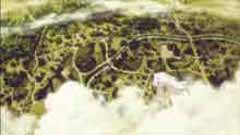 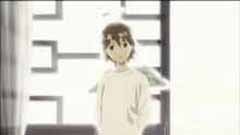 Born from a doujinshi, of all things, Haibane renmei grew to become a rather touching tale about friendship, loss, gain, responsibility, religion (to a certain extent) and the small things that brings happiness to our lives. The art and animation is very well done, mostly. I don't know if it's intentional, but the video has this.... well, hazy look. I don't rightly know whether they did this to give the show a dream-like feel or if it's just bad encoding. It does lend itself well to the show, though, so I'm not really complaining in any way. The animation is mostly top notch, except on the occational scene. This is most noticeable in a scene where Reki sits at a window, looking outside and talking to Rakka. It's no big deal since the show does everything else so well. The world, surrounded by the wall, is marvellously conceptualized and has a believability few shows can touch, much less surpass. The characters, mainly the Haibane girls that makes up the main cast, is wonderfully portrayed. The character designs are unique, in the sense that they make the plainness of the characters work for them, instilling a touch of realism not often seen in modern anime. None of the characters might have the sex appeal or the sheer gorgeousness of other anime celebrities like Faye Valentine or the goddess Belldandy, but that doesn't mean you are cheated out of watching a bunch of cute girls. *wink, wink* Rakka is usually the main focus of the show. Her "birth" from the cocoon can easily be compared to a childbirth, except she is born as a young girl instead of a baby. So, basically, her life starts -- not with babyfood, diapers and learning to talk -- but with her gaining her wings and halo before practically being thrown into the life of a teen. The fact that everything around her becomes a new experience is an interesting viewpoint, to say the least. 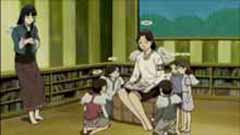 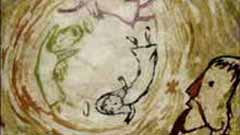 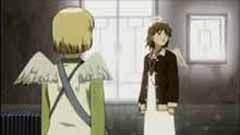 The series' plot isn't all that solid, really. We go from Rakka being born to Rakka getting used to the town and recognized as a Haibane. We go from Rakka mourning the loss of a dear friend to Rakka dealing with her past through her cocoon dream, linked to the crows somehow. Technically, you can watch any of the story sequences without missing anything particularly important in regard to the story of the moment, especially in the beginning, where everything meant to be said right then is done so in the course of one episode. It's more like "a day in the life of Rakka, one step at a time" rather than focusing on a greater problem or threat from the very beginning. However, given how the show starts, this isn't inappropriate in the slightest. Of course, Rakka isn't the ONLY person in the show. While she can probably be counted as the main character, the others doesn't get any less screen time. And what a cast we have. There's Kuu, the energetic youngster. There's Reki, the motherly, but still slightly rebellious as well as artsy girl. Kana is your token loudmouth tomboy while Hikari is more your nerdy, but still playful type. Nemu is the oldest of them, though oddly enough, she seems like the least responsible too, despite her profession as a library attendant. None of the characters' personalities is left unexplored, especially when we reach the point where the story delves into the past of a few of them. The links this show has with religion isn't as deep or involved as you might think. This series does make references to "God" as the creator of the world, including the human beings and the Haibane. Given the isolated nature of Glie, the town the Haibane and human beings share, plus the fact that the Haibane seems to live by a rather strict set of rules, especially in regard to the walls surrounding the town, one might start to wonder. However, this is by no means meant to stigmatize religion as a whole, but comes more across as a means of providing traditions and guidelines in regard to a rather loosely based belief system. For instance, the Haibane are warned not to go near the walls, much less touch it. This, again, is presented more as a reason to protect the Haibane, since Rakka, who later in the series touches the wall, contracts a life-threatening illness from it. There are also other, rather odd customs. For one, the Haibane can't earn money. Instead, they have a notebook where all their earnings are noted, and they use that to pay for any necessities they need. Secondly, any necessities like tools, furniture and clothing are only available to the Haibane if they've been discarded by the humans living in the town. While this made me raise an eyebrow as well, the story made good use of this to strengthen the relationship between the Charcoal Feathers and human beings, shown through the interaction between them. The communicator is another character I like. He's basically the communicator between the Toga -- the only people who can go outside of the walls and survive -- and the inhabitants of Glie. He also works as a priest and guidance councelor for the Haibane, and his concern towards the Charcoal feathers is heartwaming to put it mildly. It's too easy to portray characters like that as control-hungry bible-bashers without an iota of compassion. To my relief, this isn't the case here at all. He's fairly strict, and has expectation to "all his (as in God's) children" (as he calls them.) But, like I said, he is compassionate as well and spares no expense in aiding the Haibane in any way he can. 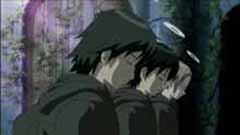 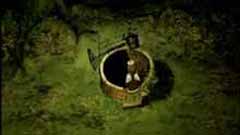 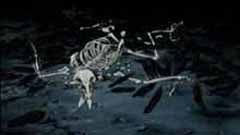 Before I wrap this review up, I simply HAVE to put in a few anecdotes about the music in Haibane Renmei, which stands as one of the most beautiful soundtracks in any anime ever. From the opening -- a folksy, instrumental guitar tune -- to the ending theme -- a somewhat new-age-like song, the series is interspersed with the kind of music that makes me all melty-kneed. Guitar, piano, flutes and drums are used to great effect, wrapping the series in a mixture of folk-rock of various origins, somber piano pieces and almost ethreal choirs. If the show is a treat to the eyes, then it's a divine salve to the ears. The show's main "flaw", if you want to call it that, is the lack of action. Well, "action" in the sense that neither of the cast has much need for stunt doubles. There is a gentleness to this series, the likes of which I haven't seen all that often. The show is seemingly content with focusing solely on drama, heavy on the people interaction. Those who come into this show expecting a lot of BANG BANG, or even a KABOOM, will probably find themselves slightly disappointed. This isn't Inuyasha, and certainly not Cowboy Bebop. If I were to draw parallells, I'd say it's more like Yokohama Shopping trip log or Fruits Basket without the comedy. There is a curious quietness about the show, not to mention a reflective one. Also, a lot of the question this show asks, is pretty much left up to the viewer to figure out. It might get a little bit too angsty for some, especially near the middle, but the characters and their trials are very heartfelt and, despite their small elements of divinity, very real. (One of the finest animated works in existance) — Stig Høgset Recommended Audience: Teens and above. The philosophy behind the show is rather hard to grasp, and there are lots of talking scenes. The characters deal with situations like regrets and loss, which are painful and possibly best understood by older audiences who have gone through similar crises. Although the overall feel of the show is very gentle and optimistic, parental guidance is probably required to explain much of this anime to younger audiences. Version(s) Viewed: R1 DVD, English Dub Review Status: Full (13/13) Haibane Renmei © 2002 ABe Yoshitoshi / Aureole Secret Factory |
 |
|
| © 1996-2015 THEM Anime Reviews. All rights reserved. |